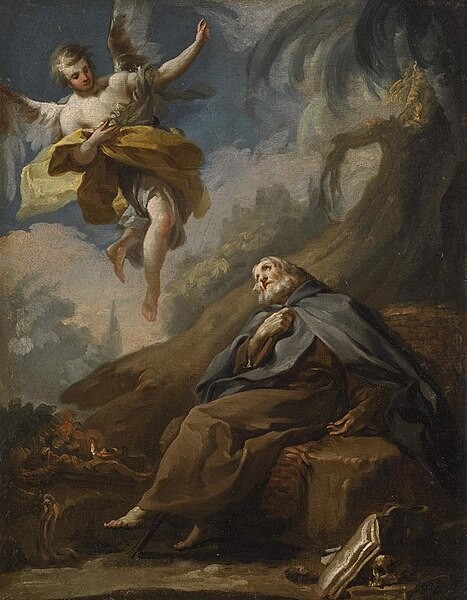- Cronología
- Ca. 1772
- Dimensiones
- 47,2 x 38,8 cm
- Técnica y soporte
- Oil on canvas
- Reconocimiento de la autoría de Goya
- Attributed work
- Titular
- Private collection
- Ficha: realización/revisión
- 27 Sep 2022 / 22 Sep 2025
- Otros títulos:
-
Found in a private collection, it was made known by Buendía in 1978, indicating that it came from Zaragoza.
The scene represents the moment before the death of the elderly St. Anthony Abbot in solitude. An angel announces its soon rise to glory. It is a reduction, sketchy and with some variations, of an altar painting made by Corrado Giaquinto around 1741-1742 for the church San Giovanni Calibita, in Rome. The figure of the angel has lost Giaquinto's rococo delicacy, as has the face of Saint Anthony, whose emotionality is enhanced in Goya's version. The objects accompanying the saint have acquired greater plasticity. They allude to his eremitical and penitent life, such as the books, the bowl, the parchment and the skull on the right of the composition and, above all, the crucifix, the scourge and the lantern on the left, bathed in the light of the latter which contrasts with the pale evening illumination of the rest of the scene. The dynamism of the composition, arranged diagonally, accentuates the expressive values already provided by the gestures and faces of the two figures.
Another reduction of the same subject attributed to Goya is in the Zaragoza Museum, Transit of St. Anthony the Abbot (2)
In 2020 a new version from a private collection was published but has not been sufficiently endorsed by critics.
-
Goya y Zaragoza (1746-1775). Sus raíces aragonesasMuseo Goya. Colección IbercajaZaragoza2015cat. 7
-
ValladolidDepartamento de Historia del Arte, Universidad de Valladolid1978pp. 30-37
-
Madrid1979pp. 260-267
-
Goya joven (1746 – 1776) y su entornoZaragozaCaja de Ahorros y Monte de Piedad de Zaragoza, Aragón y Rioja1986p. 18
-
Madrid1996pp. 353-359
-
Goya y Zaragoza (1746-1775). Sus raíces aragonesasZaragozaFundación Goya en Aragón, Ibercaja y Gobierno de Aragón2015pp. 118-119

